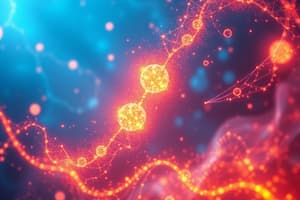Podcast
Questions and Answers
What is the formula for calculating Cardiac Output?
What is the formula for calculating Cardiac Output?
- Stroke Volume x Heart Rate (correct)
- Heart Rate - Stroke Volume
- Stroke Volume + End Diastolic Volume
- End Diastolic Volume - End Systolic Volume
Which component is responsible for the greatest rate of self-excitation in the heart?
Which component is responsible for the greatest rate of self-excitation in the heart?
- SA Node (correct)
- Purkinje fibers
- Bundle of His
- AV Node
During which phase does the aortic valve open?
During which phase does the aortic valve open?
- Systole (correct)
- Atrial systole
- Isovolumic relaxation
- End Diastolic Volume
What term describes the amount of blood remaining in the ventricle after contraction?
What term describes the amount of blood remaining in the ventricle after contraction?
Which of the following represents the relationship between Stroke Volume and End Diastolic Volume?
Which of the following represents the relationship between Stroke Volume and End Diastolic Volume?
If the SA Node fails, which structure takes over as the primary pacemaker?
If the SA Node fails, which structure takes over as the primary pacemaker?
What effect does the sympathetic nervous system have on cardiac contractility?
What effect does the sympathetic nervous system have on cardiac contractility?
What does an Ejection Fraction of 60% indicate?
What does an Ejection Fraction of 60% indicate?
What primarily influences the preload in the heart?
What primarily influences the preload in the heart?
Which term describes a slow resting heart rate?
Which term describes a slow resting heart rate?
What is a major pathophysiological characteristic of rhabdomyolysis?
What is a major pathophysiological characteristic of rhabdomyolysis?
Which of the following symptoms is not typically associated with myocarditis?
Which of the following symptoms is not typically associated with myocarditis?
Which of the following factors increases the risk of exertional rhabdomyolysis in athletes?
Which of the following factors increases the risk of exertional rhabdomyolysis in athletes?
What physiological effect can result from myocarditis?
What physiological effect can result from myocarditis?
What can be a consequence of increased myoglobin in the blood due to rhabdomyolysis?
What can be a consequence of increased myoglobin in the blood due to rhabdomyolysis?
What is the primary role of ATP in the body?
What is the primary role of ATP in the body?
What is the basal metabolic rate?
What is the basal metabolic rate?
Which factor is NOT associated with an increase in metabolic rate?
Which factor is NOT associated with an increase in metabolic rate?
How is daily energy expenditure primarily affected?
How is daily energy expenditure primarily affected?
Which thermometer method is considered the gold standard for measuring body temperature?
Which thermometer method is considered the gold standard for measuring body temperature?
What physiological purpose does fever serve?
What physiological purpose does fever serve?
What type of molecule causes the hypothalamus to change the body's temperature set point?
What type of molecule causes the hypothalamus to change the body's temperature set point?
What is thermogenesis?
What is thermogenesis?
What prevents back-flow during ventricular systole in the heart?
What prevents back-flow during ventricular systole in the heart?
In which part of the heart does blood enter through the Mitral valve?
In which part of the heart does blood enter through the Mitral valve?
Which type of muscle is cardiac muscle classified as?
Which type of muscle is cardiac muscle classified as?
Where does blood go after passing through the pulmonary arteries?
Where does blood go after passing through the pulmonary arteries?
Which valves are classified as atrio-ventricular valves?
Which valves are classified as atrio-ventricular valves?
What structure separates the atria from the ventricles in the heart?
What structure separates the atria from the ventricles in the heart?
What is the role of papillary muscles in the heart?
What is the role of papillary muscles in the heart?
Which structures in cardiac muscle are especially permeable to the movement of ions?
Which structures in cardiac muscle are especially permeable to the movement of ions?
What type of blood enters the right atrium of the heart?
What type of blood enters the right atrium of the heart?
Which of the following describes the nature of the right and left atria?
Which of the following describes the nature of the right and left atria?
Flashcards are hidden until you start studying
Study Notes
Metabolism
- Calorie: Energy needed to raise 1 gram of water by 1 degree Celsius.
- Kilocalorie (kcal): Unit for measuring energy content in food or energy expenditure in humans.
- ATP: Central energy molecule for muscle contractions, nerve conduction, and active transport.
Daily Energy Expenditure
- Basal Metabolic Rate (BMR): Calories used to maintain homeostasis.
- Metabolic rate increases during sleep; the brain remains highly active.
Factors Affecting Metabolic Rate
- Activity level, lean body mass, and hormonal factors (thyroid, growth hormone, testosterone).
- Environmental factors: fever, cold climate, small body size (enhanced heat loss).
Body Temperature Measurement
- Normal healthy range: 97 to 99 degrees Fahrenheit.
- Core temperature (biotemperature) can be measured using esophageal probes or rectal thermometers.
- Oral temperature measurement can be affected by intake of hot/cold substances.
Heat Sources
- Thermogenesis: Body's heat production process.
- Fever: Physiological response mediated by pyrogens, influencing the hypothalamus to raise body temperature.
Cardiac Anatomy
- Blood flow pathway: Right atrium → tricuspid valve → right ventricle → pulmonary arteries → lungs → left atrium → pulmonary veins → left ventricle → aortic valve → aorta.
- Right and left atria function as syncytia, facilitating coordinated electrical activity.
Heart Valves
- Mitral and tricuspid valves are atrioventricular (AV) valves that prevent backflow during ventricular systole.
- Chordae tendineae and papillary muscles assist in valve function.
Cardiac Cycle
- Phonocardiogram and electrocardiogram (ECG) provide information on heart sounds and electrical activity.
- End Diastolic Volume (EDV): 130 ml; End Systolic Volume (ESV): 50 ml; important for calculating stroke volume (SV).
Cardiac Output
- Stroke Volume (SV): EDV - ESV.
- Cardiac Output (CO) = Heart Rate x SV.
- Ejection Fraction (EF) = SV/EDV indicates heart efficiency.
Blood Pressure Fundamentals
- Arterial blood pressure is influenced by cardiac output and peripheral resistance.
- Control mechanisms include heart rate modulation and vascular resistance adjustments.
Cardiac Conduction System
- SA Node: Pacemaker of the heart, located in the right atrium, initiates action potentials facilitating atrial contraction.
- AV Node: Delays signal to ventricles, allowing for synchronized contractions.
Electrocardiogram (ECG) Basics
- Electrical cardiac events monitored through P wave (atrial depolarization), QRS complex (ventricular depolarization), and T wave (ventricular repolarization).
Heart Rate Control
- Bradycardia: Slow heart rate; Tachycardia: Fast heart rate.
- Autonomic nervous system balances heart rate through sympathetic (increase) and parasympathetic (decrease) actions.
Cardiac Contractility
- Influenced by preload (ventricular filling) and afterload (resistance against ventricular ejection).
- Positive inotropic effects enhance contractility; negative inotropic effects diminish it, regulated by calcium levels.
Rhabdomyolysis
- Condition of severe skeletal muscle damage leading to toxic release into circulation.
- Symptoms include brown urine, pain, weakness; risk factors involve dehydration and high exercise intensity.
Myocarditis
- Inflammation of the heart muscle resulting in possible scar formation.
- Symptoms may include referred pain, fatigue, shortness of breath, and irregular heartbeats.
Physiological Effects of Myocarditis
- Can lead to low blood pressure, increased heart workload, cellular death, and potential arrhythmias.
Studying That Suits You
Use AI to generate personalized quizzes and flashcards to suit your learning preferences.




